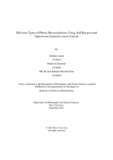| dc.contributor.advisor | Hossain, Dr. M. Mahboob | |
| dc.contributor.author | Zaman, Ifthikhar | |
| dc.contributor.author | Al Shahariar, Mahruf | |
| dc.contributor.author | Howlader Emu, MD. Rezanur Rahman | |
| dc.date.accessioned | 2023-07-11T05:50:02Z | |
| dc.date.available | 2023-07-11T05:50:02Z | |
| dc.date.copyright | 2022 | |
| dc.date.issued | 2022-12 | |
| dc.identifier.other | ID: 19136034 | |
| dc.identifier.other | ID: 19136043 | |
| dc.identifier.other | ID: 18336018 | |
| dc.identifier.uri | http://hdl.handle.net/10361/18721 | |
| dc.description | This thesis is submitted in partial fulfillment of the requirements for the degree of Bachelor of Science in Biotechnology 2022. | en_US |
| dc.description | Catalogued from PDF version of thesis. | |
| dc.description | Includes bibliographical references (pages 53-56). | |
| dc.description.abstract | Plastic is a recalcitrant molecule that cannot be easily biodegraded. As a result, almost all the
plastic that has been manufactured is still in the world. There are microplastics in everywhere
like air, water, soil, and specialty foods. A recent discovery suggests we have microplastics in
our blood and even microplastics can be transferred from mother to newborn child. There are
many types of plastics, and in this research three types of plastics were used, Polyethylene
(PE), Low-Density Polyethylene (LDPE), and Expanded Polystyrene (EPS). Two types of
samples were used, soil and Zophobas morio larvae. From the soil sample, three types of
bacteria were isolated and identified using biochemical tests and ABIS online software where
Prolinoborus fasciculus was predominant. These bacteria remained alive for the last six months
of incubation in minimal salt broth with only the carbon source being PE. On the other hand,
Zophobas morio, a super worm, was used to find out the biodegradation capability in the larvae
stage of the insect and also larvae feces bacteria that is responsible for aiding the larvae in
digesting the plastics. The larvae consumed 47.07% LDPE, 30.51% EPS, and 26.32% PE in
about two months, and in the duration of the experiment no larvae died and they were also seen
to recycle their feces. From feces, four bacteria were isolated according to colony morphology
that was incubated in minimal salt broth for two months with the sole carbon source being the
aforementioned particular plastics, and by doing 16s rRNA sequencing, Pseudomonas
guariconensis, and Pseudomonas aeruginosa were identified. | en_US |
| dc.description.statementofresponsibility | Ifthikhar Zaman | |
| dc.description.statementofresponsibility | Mahruf Al Shahariar | |
| dc.description.statementofresponsibility | MD. Rezanur Rahman Howlader Emu | |
| dc.format.extent | 56 pages | |
| dc.language.iso | en | en_US |
| dc.publisher | Brac University | en_US |
| dc.rights | Brac University theses are protected by copyright. They may be viewed from this source for any purpose, but reproduction or distribution in any format is prohibited without written permission. | |
| dc.subject | Plastic bioremediation | en_US |
| dc.subject | Soil bacteria | en_US |
| dc.subject | Superworm Zophobas morio Larvae | en_US |
| dc.subject.lcsh | Plastic scrap--Environmental aspects. | |
| dc.title | Different types of plastic bioremediation using soil bacteria and Superworm zophobas morio larvae | en_US |
| dc.type | Thesis | en_US |
| dc.contributor.department | Department of Mathematics and Natural Sciences, Brac University | |
| dc.description.degree | B. Biotechnology | |

